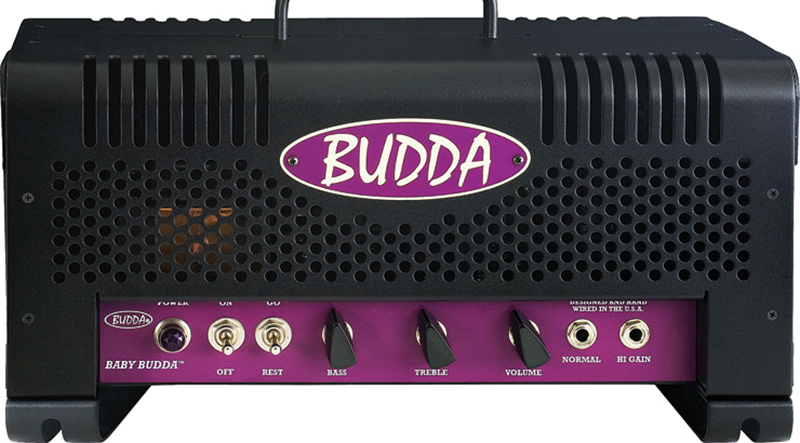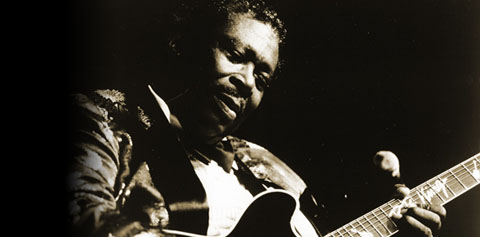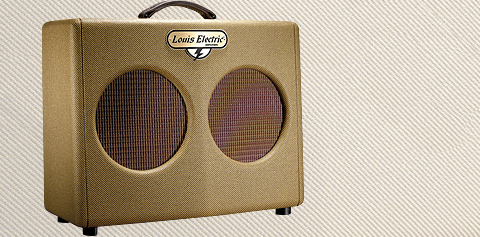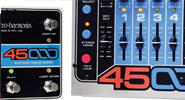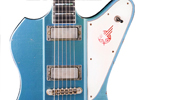

The recipe for such an iconic rock guitar might include an instrument that was part of the establishment – in this case, the Cadillac of old-school archtops as endorsed by none other than Chet Atkins. Then, that chosen guitar had to be forced to play the “Devil’s music,” and along the way was covered in scratches, stickers, and hot-rod emblems. Finally, it had to have a voice of its own – proven here by the jangly D-chord intro to “Rock This Town” or that oh-so-cool diminished-scale solo that crowns “Stray Cat Strut.”
Setzer might not have been part of the first wave of rock and roll – coincidentally, he was born in 1959 – but, the original Stray Cat guitar, serial number 33024, has a suitably rock-and-roll story that Setzer recently shared with VG, along with many a laugh, hoot, and song accompaniment played on the guitar.
“I bought the Gretsch in ’76 or ’77,” he says. “Making it playable, that was the 40-year struggle!”
The inspiration? One man; the consummate rocker, Eddie Cochran.
“What really started me on the Gretsch, I remember walking into the local record store in my home town, Massapequa, on Long Island,” Setzer says. “The owner hung the album covers on fishing line so it looked like they were just floating in midair and spinning around. When I saw that picture of Eddie Cochran on the cover of that ’72 Legendary Masters LP and he had that Gretsch and his hair slicked back, I said, ‘Oh my god, that’s the guy.’
“I didn’t know who this guy was. I’d never heard his music, but I wanted to be him. I wanted to look like him. I bought the record and went home and it absolutely changed my life.
“It was the whole package. It turned my life around. I just wanted to get out of school, get that guitar plugged in, get a look going, and start a band. Cool is cool – doesn’t matter when it’s written.
“Naturally, I had to track down that guitar. I didn’t know a Dynasonic from a Filter’tron from a humbucker, I just wanted that orange guitar. I saw one in our local shopper, the Buy Lines Press. It said, ‘Gretsch guitar. Orange. 100 bucks.’ I called the guy and asked, ‘Is it like Eddie Cochran’s?’ And he said, ‘Who?’ He goes, ‘If you want it, you better come over because I have all the electrics out and I’m going to refinish it.’ And I said, ‘Okay, I’ll come right over.’ I had scrapped and saved that hundred bucks, you know? That was a lot of money for a 16-year-old kid.
“Anyway, he had the pickups and the wiring harness in a shoe box, and had started to sand one little spot right above the knobs, by the f hole… it looked as if he was going to stain it natural.”
After saving the guitar from refinishing and other potential indignities, Setzer took it to a local repair shop run by Jess Oliver, of Ampeg fame. “He put it back together for me. So, I had a whole guitar!”
Setzer’s guitar dates from what may have been the last batch of 6120s built in ’59, according to Edward Ball, author of the seminal book Gretsch 6120: The History of a Legendary Guitar.
“Its vintage is an interesting story,” Ball explains. “The 1959 model-year 6120s are characterized by their 2.75″-deep body spec and black-enamel-faced Bigsby. The 1960 6120s are defined by their 2.5″-deep body and V-style Bigsby. But it’s not quite that clean, because the V-style Bigsby was introduced early in the last couple ’59 batches of 6120. So, body depth becomes the defining feature between the ’59 and ’60 6120 guitars.
“Brian’s has a non-original Bigsby, and it would have had the V-style unit coming out of the factory; most people don’t realize that, and it has contributed to the confusion about that guitar’s vintage. In reality, the batch with serial numbers that start with 33 where made when the 1960 model year debuted, and that occurred midway into the batch of 100 6120 guitars.
“My research has verified that Brian’s guitar, with serial number 33024, was one of the very last 6120s to receive the 2.75″ body depth, which is why I’m comfortable attributing it to the ’59 model year. If it was two guitars later on the production line, it would have received the shallower body and would have to be considered a 1960 guitar.”
After visiting Oliver’s shop, Setzer went in search of a case to protect his $100 investment. “I took the bus with my guitar in-hand, like only a kid would do, and went to Sam Ash – that was our store. I said, ‘Do you have a case that would fit this?’ The guy rolled his eyes, like this was the last thing he wanted to deal with – a kid needing just a case. They had a big conveyor belt that went into the basement, and he yelled down, ‘Saul, we need a case for a Gretsch.’ And up comes that original cowboy case. They had one!
“Somehow, it was just meant to be! I don’t take things like that for granted any more. I used to, but I don’t think it was coincidence. Somebody had something planned!”

“The first thing I did was take a hammer and chisel, and knock out that zero fret. I knew that thing was up to no good. It was just holding the strings, and they would make a groove in it. It was an idea that might have worked for Chet, but it didn’t work for me. I also had someone move the nut up to where that zero fret was. So, behind it then, there was just an empty slot.
“The next step was to swap on the best tuners you could get then, which were Schallers. They didn’t lock, but they were a step up from the old Waverlys.”
His next step was to “fix” the bridge. “It had that bar bridge that was useless because I couldn’t get the guitar to intonate properly. It was always sliding around. So, I first put a screw in it, then we finally got the bright idea to use double-sided tape.
“I needed something with saddles so I could move them back and forth. The only thing available was the Gibson bridge, which I still use because that thing works great. And that got it pretty close.”
Pretty close to playable, but not loud enough.
“I wasn’t getting enough volume from the rear pickup, so I stuck matchbooks under it to raise it. The pole pieces weren’t adjustable; I actually took the pickup out, folded a couple of matchbook covers [under it], then screwed the pickup covers back on so I could get the thing closer to the strings. That was the mind of a 16-year-old: ‘I need to play a gig, the guitar ain’t rocking, something’s not right.’ So, I made it work. It’s still that way, still with the original pickups.”
Next, he turned his attention to the tone. In ’59, the 6120 had been given a second toggle switch with a Tone knob near the three-way pickup selector on the upper bout. If he was going to play rock and roll, Setzer quickly realized that Tone control had to go.
“I call it the ‘mud switch.’ I don’t know if I coined that or someone else did, but it’s become a popular term.
“The real pickup selector was on top, the mud switch was on bottom. I thought, ‘What’s the use of this thing?’ Maybe if you’re trying to be Johnny Smith or something, it gives you a really good jazz sound. But I had no use for it.

Setzer was indeed using the guitar. In the late ’70s, he played in an art-rock band called the Bloodless Pharaohs. “It was cool,” he remembers. “Kind of like Roxy Music meets some other weird English band. It was very musical.” Setzer usually played a Strat with that band; today, it’s hard to imagine. “But, I had the Gretsch, and we ended [shows] with a rockabilly song that always brought the house down. I thought, I’ve got to make up my mind here. The rockabilly stuff is what’s paying the bills.’”
In January of 1979, Setzer launched the Tomcats, playing rockabilly in Long Island clubs. The band included his brother, Gary, on drums and fellow Pharaoh Bob Beecher on bass. But, as Setzer made his realization that rockabilly might pay – hard to believe in those days of new wave – tension broke the band apart.
Setzer then joined with two Long Island buds, bassist Lee Drucker (soon to be Lee Rocker) and drummer Jim McDonnell (a.k.a. Slim Jim Phantom). In the summer of 1980, the trio became the Stray Cats, and moved to London, where rockabilly had never died. Setzer went there with the Gretsch 6120 in hand.
He never updated the electronics, but did hot-rod its looks.
“I had to rock it out. I got the decals from Ed’s Lawn Mower Repair… I kid you not! He had decals from the ’50s in a box on a shelf. I said, ‘I want the pinup girl! I want the skull!’ I had to customize it like a hot rod. You know, I wanted to make it my guitar. I thought they looked cool… For some reason, I thought the skull would look good over the [original headstock inlay of a] horseshoe, which might have been a little old-fashioned – it was the era of punk rock and all that.”
The Stray Cat guitar went through a series of decal iterations. Setzer first added the skull-and-crossbones to the headstock, plus the small black cat and “Lucky Lady” decals on the lower bouts (this version was replicated for Gretsch’s Tribute reissue in 2006).
Ball notes that at some stage, Setzer replaced the original pin-up-girl decal with one of a sunbathing beauty riding a hot-wax platter. He also added dice to replace the staid Gretsch control knobs with their wild-west arrows.
“It’s an old hot-rodder trick, putting dice on anything. The guitar didn’t have the original knobs when I got it, so I got the dice out of my old game of Monopoly, took Dad’s drill, and I drilled a hole so they’d just fit over the shaft, then poured super glue in there. It was that simple.”
The Gretsch lived a hard life in Setzer’s hands – one it was not truly made for.
Asked if he had any issues with the neck bowing, he said, “Absolutely! The neck was always bowing and would have to be put in a steam press.
“I’ve left that guitar in the back of London taxicabs after playing some pub, and they were honest enough to say [switching to his best Cockney accent], ‘Oy, mate. You left your guitar here!’

“It’s not coincidence! I’m telling you, you got to believe in something.”
These days, the guitar is in well-earned semi-retirement. “I’m giving it a break. I don’t take it out on the road anymore, just because I’m afraid it’s going to get lost or stolen.”
Over the years, Setzer has kept his eyes open for solid ’59 6120s to serve as backups. His main reserve bears dice knobs and the same bathin-suit-beauty decal.
“Just because it came from 1959 doesn’t mean it’s going to be a great guitar,” he warns. “The ’59 I use now I bought from a guy, also from Long Island, just after the first Stray Cats album. It had holes drilled in the back of the headstock and other things that we had to fix, but I didn’t care because I was going to customize it anyway. It sounded great and played just as good, maybe even better – they’re both ace guitars. So, I fixed that one to be playable, knocked out the zero fret and all. But that time, it was done professionally, done right. And that’s the one I’ve used since like ’93.
“I just got a third one because I don’t like taking the original guitars and messing around with them, and I needed one more backup. That one had to have the neck put in a steam press twice, along with two pages worth of other work.”
He continues to use the original for recording – his recent CD, Rockabilly Riot!, was cut entirely with one of the ’59 Gretsches, a ’63 blond Fender Bassman piggyback amp, a ’50s Magnatone, plus a Roland RE-301 Chorus Echo. As Setzer says in lauding the sound of his vintage gear, “When the old stuff’s working, I don’t want to fix it because it ain’t broke.”
On stage, however, he often plays several of his new signature 6120 models. “It’s much easier to get a new one!” he said. “They play great, right out of the box. But… let’s face it, there’s nothing like a ’59 Gretsch 6120. They’ve just got some magic about them.”
Special thanks to Aaron Feterl.
Brian Setzer recently donated a replica of his ’59 Gretsch 6120 to the Smithsonian’s National Museum of American History. The original was used during the ’80s heyday of the Stray Cats, personalized with dice (taken from his Monopoly board game) for two control knobs, and stickers depicting a black cat, skull and crossbones, and a pin-up girl. Those touches were duplicated on the replica, which was built in 2006 by Stephen Stern, master builder at Gretsch. At the Smithsonian, it joined Edward Van Halen’s “Frank 2,” Prince’s Yellow Cloud, and non-stringed instruments such as John Coltrane’s saxophone and Dizzy Gillespie’s trumpet.
“Brian Setzer is a prolific and distinctive contributor to American music,” said John Edward Hasse, the curator of American music at the Smithsonian. “Proof of his legacy exists not only in the longevity of his career and in his lengthy discography, but also in his ability to cross musical boundaries.” To learn more, visit http://americanhistory.si.edu.

Brian May’s Red Special
“I couldn’t afford to buy an electric guitar,” Brian May says about his teen years. “There was no way. I couldn’t even afford a copy of the Fenders and Gibsons that looked so enticing in the brochures. So my dad and I decided we would make one.”
The result was the Red Special, one of the most famous guitars ever built. It ranks with Les Paul’s Log and Eddie Van Halen’s Frankenstrat in being home-brewed creations that have gone on to stardom.
Like both of those guitars, the Red Special was an invention that innovated; May didn’t build the instrument simply because he couldn’t round up the shillings for your usual mass-produced, store-bought guitar. Rather, he experimented, and incorporated ideas that were far ahead of their time.
And the Red Special has served him well. He began work on it in 1963 and – following many parts swaps, numerous stage-side repairs, and two restorations – he is still playing it today, more than 50 years later.
“While the outfits, venue capacities, set lists, production, and even hair lengths varied wildly over the years, the Red Special remained the only constant,” May said of the Queen legacy.
The story of the guitar is much more than just the details of some boards, screws, wires, and electrical components. It’s the tale of a father and son crafting the guitar together, then falling out over the son’s decision to throw aside a promising career to play rock and roll. But that’s not the end of the story…
 May grew up in the nondescript London suburb of Feltham, where his father, Harold, was an electronics engineer. During World War II, he served with radar and radio detachments, and in the decades following, built the family a radio, record player, TV, and tape recorder.
May grew up in the nondescript London suburb of Feltham, where his father, Harold, was an electronics engineer. During World War II, he served with radar and radio detachments, and in the decades following, built the family a radio, record player, TV, and tape recorder.
“Dad was great at making all kinds of things,” May remembers in his new book, Brian May’s Red Special. “And though he didn’t know anything about guitars, he knew a whole lot about amplifiers, which was to become very useful.”
While the elder May was a fan of big-band jazz, young Brian became smitten by the sounds of Little Richard, Buddy Holly, and others. When he first heard Ricky Nelson’s “Hello, Mary Lou” and the thoroughly electric solo by James Burton, he knew he had to play guitar.
His parents bought a ukulele for him, then, in 1954, a simple, small-bodied Egmond acoustic. But, as rock and roll got louder and May heard the wonders of the Beatles, Jimi Hendrix, and Cream, he yearned for an electric. So, father and son made their own pickup starting with extra-fine copper wire from their workshop (in the converted spare bedroom of the family’s small suburban house) and three button magnets Brian bought at a hardware store. Winding thousands of turns by hand proved laborious and readily resulted in breaks in the fragile wire. So, Harold concocted a pickup winder from spare parts, complete with a revolution counter adapted from a bicycle odometer.
They mounted the pickup to the Egmond acoustic and ran it through their homemade radio amplifier. It worked well. However, when Brian would bend strings, the signal blurred. And, it never got a true electric-guitar sound. Not having the money to buy one, the Mays went to work in the summer of ’63.
“Dad made all kinds of stuff – test instruments for radios and TVs – and he had tools. He also had a lot of stock he thought might be useful one day, and if we wanted something for the guitar, we could normally find it in a corner of the workshop.”
Brian brought something to the project beyond a budding rocker’s passion. At school, then at university, he was studying math and physics (he would eventually earn a PhD in astronomy), so he had the mind to analyze the mathematical problems inherent in the construction of a guitar, such as fret distances, and could draft detailed plans for all elements of the instrument.
Together, they made the perfect father/son team. Brian’s vision was ambitious and farsighted; he planned to craft a vibrato bridge from scratch, his own three-pickup setup and switching system, and a chamber in the body.
“I had big ideas!” he says. “We did actually sit down and design it; I wanted a full electric instrument with multiple pickups and a proper tremolo.
“I wanted it to look like an acoustic guitar that had been cut away; it’s my own shape,” May explains. “I started with something that’s more or less the Egmond shape, then did my own cutaways. I decided on two because I genuinely wanted to get up to the top end of the fingerboard.”
They began with a piece of an oak table as the basis for the central block running through the body. “It was hard, like steel, and to fashion it took hours of work – it blunted all of our tools and gave us blisters on our hands!” They then added “wings” made of blockboard and covered the whole with mahogany veneer.
The body is semi-hollow. “It was designed to feed back in the right way – not so you’d get a booming body sound, but enhancing sustain through the strings. I think that was a first.” May originally planned to cut an f-shaped sound hole into the top, but decided the feedback was right without it.

Body: chambered blockwood with central oak insert, mahogany veneer Body thickness: 1.6″ (40 mm)
Mahogany bolt-on neck with truss rod; black-painted oak fretboard Fretboard radius: 7.25″ (184.15 mm) Width at nut: 1.84″ (46 mm) Width at 12th fret: 2″ (50 mm) Frets: 24 plus zero fret Scale length: 24″ (609.5 mm) String gauge: .09-.42 Pickups: Three Burns Tri-Sonic single coils, wired in series Vibrato arm: Made from bicycle saddlebag rack Controls: Volume, Tone, on/off slide switch for each pickup, in/out-of-phase switch for each pickup Weight: 7.99 pounds (3.63 kg) Red Special front/back: Andrew Guyton.
May also modeled the neck on the Egmond, but in making it, miscalculated, forgetting to add the fretboard’s thickness. In the end, though, he was pleased with what he describes as the “huge” profile, and kept it.
“For the neck, we used part of an old fireplace that at the time was 100 years old; it was just kicking around the workshop. If you look really closely, you can still see wormholes that I filled up with matchsticks.”
He wanted the scale length to be shorter than usual, “making the fingering a little easier and tone a little brighter.” In the end, he decided on a scale length of 24″, shorter than a Gibson Les Paul or Fender Stratocaster.
“I also couldn’t see why most electrics stopped at the 22nd fret – just short of two octaves. Why not have the full two? So, the guitar was given a fingerboard that went to 24 frets.” Being a young mathematician, he created a formula and worked out the exact fret distances with a slide rule.
“The truss rod was anchored on a massive bolt which also fastened the neck to the body… so, tightening it up really held the neck rigid,” he says. “The neck is so robust it has never needed any truss-rod adjustment.”
It has also never needed a fret job. May made a tool to set the frets, and despite several times replacing the zero fret, they’ve served their time. He made dot markers out of mother-of-pearl buttons sourced from his mum’s sewing box.
May designed the headstock to allow the string to run straight laterally and vertically, so no friction was added to the vibrato setup. He used store-bought tuners – the only element other than its replacement pickups that were not made by May and his dad.
From there, they turned to the components.
“All of the hardware and electrics were designed from scratch,” May says. Again, he drew schematics and graphs for the parts. “The materials were, in many cases, made from things lying around Dad’s workshop – little pieces of steel, brass, and aluminum, washers, nuts and bolts and screws, and occasionally less-common objects.” For instance, the vibrato arm was made from a saddlebag support from a bicycle, while its tip came from one of his mum’s knitting needles.
For the tailpiece, May began with theory – and inspiration from Hank Marvin with the Shadows. “There were no such things as tremolos and tremolo-friendly bridges in those days; there were just loose screws!” he remembers. “I wanted to make sure that if the tremolo was used even to extremes, the strings would return to correct pitch. The Fender Synchronized Tremolo system was essentially just some screws that aren’t fully screwed in and a bridge piece that wobbled about.”
May’s uses two valve springs borrowed from a Norton motorcycle. Rather than stretching the springs to provide constant tension, as with the Fender bridge, his were designed to be compressed. “Unusually for the time, it sat completely in equilibrium in the center position,” he explains. “So, I could rock the pitch smoothly either way. I could take the bottom string down an octave and, in the days when we first went out as Queen in 1970, people would be curious as to how that could happen, but it was just because the tremolo was truly floating and returned to pitch.”
To keep the bridge from creating friction on the strings, he made separate roller saddles for each string – a laborious job using just a hand file and drill! The rollers sat freely in bridge blocks; if he broke a string while playing, the roller wanted to fly free, so he always keeps spares in his pocket.
“The roller bridge was unique in those days, and everybody was saying I should have patented it, but patents are a pain in the neck. Besides, why not share everything with the world?”
May hand-made three pickups, but was never satisfied with them, so he eventually trekked to the Burns music shop on London’s Tottenham Court Road, to buy the three Burns Tri-Sonic single-coils that are still in it today. Combined with a Dallas Rangemaster treble booster and Vox AC30, the Red Special finally had its voice, he says.

“I devised my own system for switching between combinations of the three pickups so that all the possible combinations of three pickups, in and out of phase, could be used in performance,” he says. “To my knowledge, nobody had attempted a system like this.”
Covering the electronics is a pickguard made of black Perspex, an early transparent plastic. He wanted the guitar to be easy to service, so all of the electronics are screwed into the body and the pickguard lifts free.
Controls were simple, just Volume and Tone potentiometers. Each has been replaced several times as they wore out.
Initially, May used a Vox Fuzz effect unit inside the guitar, with its small, red on/off slider switch peeking through the pickguard.
“I had an instantly deployable fuzz tone,” he explains. “However, pretty early on, I realized what I wanted was the kind of smooth distortion and compression you get from a valve amplifier, and the fuzz didn’t do that.” Taking it out left a hole in the pickguard, which was later filled with a “Brian May star.”
Building the guitar in their spare time took father and son two years, using hand tools – planes, chisels, and saws – and a lot of sandpaper, fashioning the thing out of bits and pieces,” he says. “A lot of swearing went on, but eventually we got there. Quite often, we’d slip up and something would go wrong, and we’d think the whole thing was ruined. But we’d find some way around it, and repair it.
“It was character-forming. Building this thing became our lives for two years, and we had to learn to forgive ourselves as well as try to achieve perfection. Lots of important life lessons there!
“Dad was really great. He was helpful with anything I wanted to do; any passion I had, he’d back me up and get into it. I know he enjoyed building the guitar very much, and I don’t think we ever fell out over it.”
May and his dad certainly bonded while building the guitar. But when it was finished, things went awry.
“Dad and I got on very well during this period and it’s odd because the trouble happened later,” he says. During this time, May was studying at school and then university, working toward his PhD. “I was pursuing the kind of life that Dad imagined I was destined for – something academic – and the guitar was just a great hobby.”
May first played the guitar in 1966, at the Molesey Boat Club in Putney, with his early band, called 1984. Their repertoire included songs like the Spotnicks’ “Happy Hendrik’s Polka,” Motown tunes such as “My Girl” and “Knock On Wood,” and covers of Cream and Hendrix.
May soon dropped his studies and devoted himself to music. “Dad just could not compute it. He said, ‘You’ve got this far, you have all this education.’ And, of course, he’d sacrificed a lot of his life and worked so hard to get me through university. He just couldn’t believe I was chucking it all to be a pop star… or failure!”
The Red Special became the wedge between them. Their relationship broke down and they hardly spoke.
That all changed on February 5, 1977, when Queen played Madison Square Garden for the first time. To see the show, May flew his parents on the Concorde and put them up in the Ritz. He remembers the event fondly.
“My parents sat in the audience, and the response we got from that audience was just mind-blowing. Dad wasn’t a physical, ‘huggy’ kind of person, but he came backstage afterward, shook my hand, and said, ‘Okay… I get it. I see what you’re doing, and why it is so important to you.’
“That was a big moment for me, as it swept away all the problems that we’d had and, from that point on, he was unreservedly into the music. I think secretly he always had been, but now, being a musician, he was able to give himself over to it and enjoy it. That was a godsend for me. You can be a rebel, and we all do it – kick against our upbringing. But, in the end, no matter how far you’ve wandered off the rail, you always want your parents’ approval.”
Adapted from Brian May’s Red Special, by Brian May with Simon Bradley, ©2014 Duck Productions Limited and Carlton Books Limited. Reprinted by permission of Hal Leonard.
This article originally appeared in VG‘s February 2015 issue. All copyrights are by the author and Vintage Guitar magazine. Unauthorized replication or use is strictly prohibited.

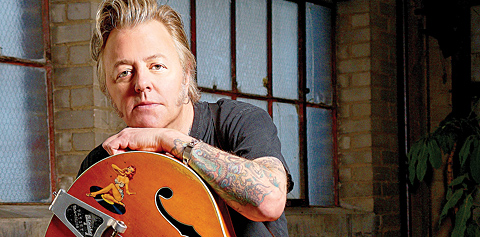



 On the other hand, Turner used a vintage Fender Jazz bass borrowed from producer Matt Mangano, but recently acquired another bass he plays live.
On the other hand, Turner used a vintage Fender Jazz bass borrowed from producer Matt Mangano, but recently acquired another bass he plays live.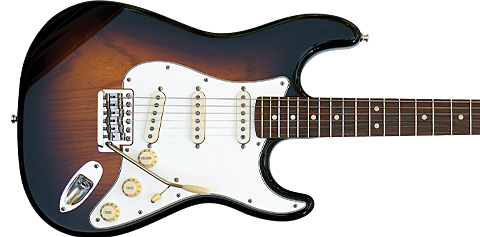

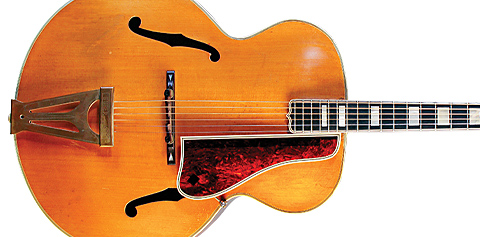

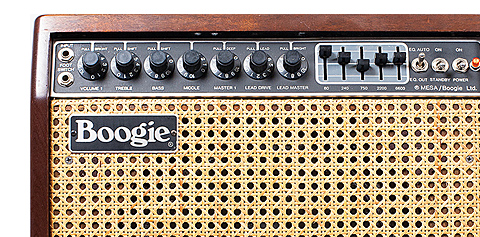


 Like the Mark amps before and after them, Mark IIC+ Boogies were available with a range of options. To the base 60-watt head or combo you could add reverb, graphic EQ, 100-watt output stage with SimulClass (a simultaneous use of Class A and Class A/B tube pairings, or one or the other independently), an export power transformer, an upgraded Electro-Voice or Altec speaker, and an exotic hardwood cabinet with wicker grille. Our featured amp, owned by Todd Duane, is a rare example of a rare breed, with all the extras other than the export transformer (pointless in and of itself, unless you plan to tour outside North America). It’s a major looker, too, in outstandingly clean and original condition, with a luscious Bubinga cabinet. Of its tone and performance, Duane tells us this “is one amp that can really do all styles exceedingly well. I’ve used mine for country, worship, and Top 40 classic rock gigs. You can do it all; metal (Metallica ‘Master Of Puppets’), progressive rock (Dream Theater), whatever you want to dial in. The clean channel is a great warm-blackface-type clean, while the gain channel has an awesomely warm, squishy and chewy rhythm/lead tone.”
Like the Mark amps before and after them, Mark IIC+ Boogies were available with a range of options. To the base 60-watt head or combo you could add reverb, graphic EQ, 100-watt output stage with SimulClass (a simultaneous use of Class A and Class A/B tube pairings, or one or the other independently), an export power transformer, an upgraded Electro-Voice or Altec speaker, and an exotic hardwood cabinet with wicker grille. Our featured amp, owned by Todd Duane, is a rare example of a rare breed, with all the extras other than the export transformer (pointless in and of itself, unless you plan to tour outside North America). It’s a major looker, too, in outstandingly clean and original condition, with a luscious Bubinga cabinet. Of its tone and performance, Duane tells us this “is one amp that can really do all styles exceedingly well. I’ve used mine for country, worship, and Top 40 classic rock gigs. You can do it all; metal (Metallica ‘Master Of Puppets’), progressive rock (Dream Theater), whatever you want to dial in. The clean channel is a great warm-blackface-type clean, while the gain channel has an awesomely warm, squishy and chewy rhythm/lead tone.”